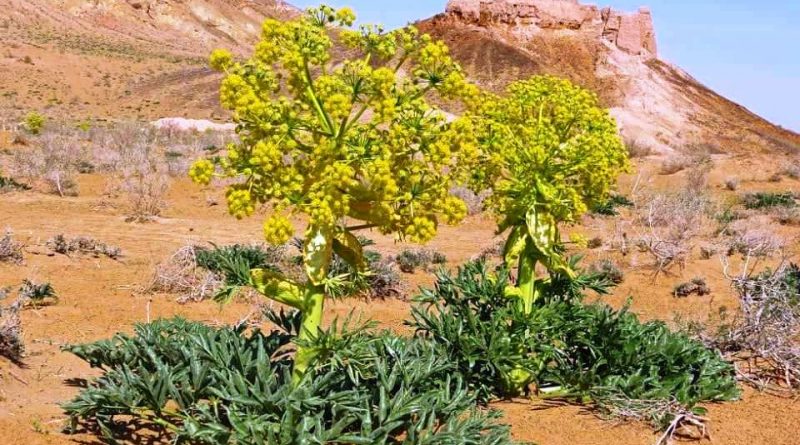Dorema ammoniacum
Dorema ammoniacum
Dorema or Ammoniacum (Dorema ammoniacum D. Don, 1831) is a herbaceous species belonging to the Apiaceae family.
Systematics –
From a systematic point of view it belongs to:
Eukaryota Domain,
Kingdom Plantae,
Magnoliophyta Division,
Magnoliopsida class,
Apiales Order,
Apiaceae family,
Genus Dorema,
D. ammoniacum species.
The terms are synonymous:
– Diserneston gummiferum Jaub. & Spach;
– Diserneston hirsutum Lofius ex IGBorshch .;
– Dorema gummiferum (Jaub. & Spach) KMKorol .;
– Dorema hirsutum Lofius ex IGBorshch .;
– Ferula ammonifera (D. Don) Oken;
– Peucedanum ammoniacum (D.Don) Baill ..
Etymology –
The term Dorema comes from the Greek dṓrēma which means gift.
The specific epithet ammoniacum refers to the surroundings of the Temple of Jupiter Ammon in the Libyan desert, where in ancient times the resin of this plant was collected from which ammonium salts were extracted to produce ammonia.
Geographic Distribution and Habitat –
Dorema ammoniacum is a plant native to Asia, from Iran to Afghanistan and Pakistan.
Its habitat is that of desert areas and arid rocky soils.
Description –
Dorema ammoniacum is a perennial plant that grows up to 2.5 m in height and one m of base.
It is a hermaphrodite species (it has both male and female organs) and is pollinated by insects. The plant is self-fertile.
The leaves are dark green, alternate, without stipules, and composed of finely perforated leaves.
The flowers, small, pentamers, with radiated symmetry, yellowish, are made up of 5 petals and 5 reduced sepals, the androecium is formed by 5 stamens, the ovary is inferior formed by two carpels. The ovary bears two styles which widen at the base in a nectarous disk.
The flowers are carried by a large umbrella that emerges above the leaf part.
The dried fruits are diachenes that split in two when ripe, each part containing a seed.
Cultivation –
Dorema ammoniacum, even if it is a plant that has adapted to desert and arid areas, can grow very vigorously in a normal, more fertile garden soil.
In general, however, it prefers well-drained to dry soil in a sunny position.
The plant tolerates temperatures down to at least -5 ° C.
It is a monocarpic species, growing for several years before blooming after which it dies.
From the stems damaged by insects exudes a medicinal gum or resin called “Ammoniacum” which is also used in perfumery and porcelain cement as well as for plasters.
The plant can be propagated by seed, in outdoor seedbeds, in the period of April, or even in autumn in a cold greenhouse.
The seed germinates in 2 – 6 weeks at 15 ° C.
Customs and Traditions –
The resin of this plant oozes especially when it is pierced by insects (especially beetles); the milky rubber, on the other hand, naturally exudes and hardens in contact with the air, forming the “ammonia tear” of the trade. Lump ammoniacum, the other form of the substance, is instead made up of aggregations of tears, which often incorporate fragments of the plant itself, as well as other foreign bodies.
This dries in contact with the air and forms drops (called tears) or solid blocks that are collected by local populations.
This plant is the main source of ammonia gum, a gum also used since ancient times for its medicinal properties and is also used in perfumery and for the production of silicate cement.
The ammonia resin has a faintly fetid and unpleasant odor that becomes clearer with heating; externally, it has a reddish-yellow appearance and when the tears or bumps are recently fractured they show a waxy sheen.
This is mainly harvested in central Persia and arrives on the European market via Bombay.
Dorema ammoniacum has been used in Western herbal medicine for thousands of years and is still seen as an effective remedy for various chest ailments. A rubbery resin is found in the tissue cavities of stems, roots and petioles.
The resin is antispasmodic, carminative, diaphoretic, slightly diuretic, expectorant, poultice, stimulant and vasodilator.
It is also often used internally in the treatment of chronic bronchitis (especially in the elderly), asthma and phlegm.
Externally it is used as a patch for joint swelling and indolent tumors.
Preparation Method –
The rubber obtained from Dorema ammoniacum is pressed into blocks and then ground into powder.
This is then used directly or in some preparations both for medicinal use but also for other uses, such as in construction.
Guido Bissanti
Sources
– Acta Plantarum – Flora of the Italian Regions.
– Wikipedia, the free encyclopedia.
– Useful Tropical Plants Database.
– Conti F., Abbate G., Alessandrini A., Blasi C. (edited by), 2005. An annotated checklist of the Italian vascular flora, Palombi Editore.
– Pignatti S., 1982. Flora of Italy, Edagricole, Bologna.
– Treben M., 2000. Health from the Lord’s Pharmacy, Advice and experiences with medicinal herbs, Ennsthaler Editore.
Warning: Pharmaceutical applications and alimurgical uses are indicated for informational purposes only, they do not represent in any way a medical prescription; we therefore decline all responsibility for their use for curative, aesthetic or food purposes.


